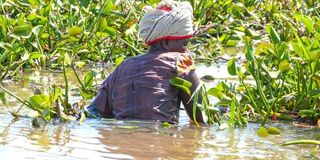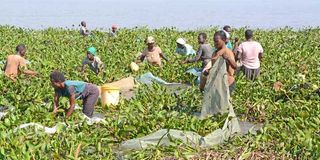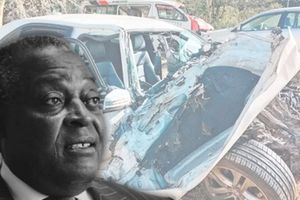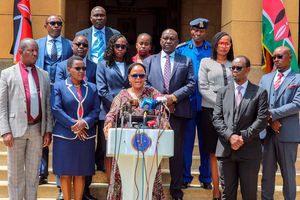Inside Lake Victoria's waters where women choose death over their children's hunger

A woman places her fishing gear under water hyacinth offshore in Lake Victoria on October 30, 2024. The women from Sango Rota know it's fatal. They wade in anyway. Because their children must eat.
What you need to know:
- In the village of Sango Rota near Lake Victoria, climate change-induced flooding has forced hundreds of women to engage in a lethal form of fishing.
- These desperate mothers with submerged farmlands, knowingly risk deadly diseases like bilharzia and face dangers from hippos and snakes daily, simply to feed their children.
Sango Rota lies in ruins, a lakeside village that bears the scars of nature's fury. Precariously hanging mud houses threaten to collapse at the slightest provocation, while others have submerged. As morning breaks, the chilly sun casts a soft light across scattered pools in this West Nyakach settlement of Kisumu County.
The village stands nearly empty. Its residents fled from what has become a ghost of its former self. Once again, Lake Victoria's merciless backflow has unleashed its wrath, leaving behind submerged homes and farmlands and devastating losses of livestock and crops.
Our path leads to a modest mud-walled house, partially draped in a piece of cloth. Inside Pamela Omuru’s home, three rooms tell a story of resilience amid hardship. The makeshift sitting room holds two wooden chairs, while in the kitchen, Pamela's teenage daughter prepares black tea – their first meal of the day. She cradles a five-month-old baby, born early last year, leading to her dropping out of school.
As we settle in, Pamela emerges from her dimly lit bedroom, crawling slowly across the floor. She pauses every few seconds, her body betraying her struggle. Her legs are swollen, her skin and eyes pale, a testament to weeks without proper medical care. “The last time I visited the hospital, they referred me to Jaramogi Oginga Odinga Teaching and Referral Hospital, but I haven't been able to go. No funds,” Pamela whispers weakly from her mat, against the wall.
Here, she unfolds the story of nyanam – a disease she contracted while working in Africa's largest freshwater body that would transform her life forever. Until 2004, Pamela worked alongside her husband, a fisherman in Dunga, Kisumu. His death that year after a brief illness left her solely responsible for their three children.
Unable to maintain a steady fish supply, she relocated to her husband’s village in Sango Rota, Nyakach. The widow, barred from joining male fishing expeditions, turned to farm labour, channelling her meagre earnings into family needs.
Farmlands
In 2019, Lake Victoria’s backflow swallowed most farmlands, leaving the 48-year-old jobless. “With no income source, I joined other village women in a local fishing method that required us to immerse ourselves in deep waters,” Pamela recalls, her voice barely audible.
Most of these women shared similar stories – widowed, their farms claimed by rising waters, or both. At 6am each morning, Pamela would wade into the lake, returning at 4pm with just one brief break at 10am for household chores.
The women search for small, snake-like fish measuring less than 10 centimetres, known locally as nyapus (small clarias spp). These fish thrive beneath the water hyacinth floating on the lake’s surface. The fishing method requires women to plunge deep into the waters, casting nets around the hyacinth before dragging their catch to the shore.
A good day might yield 300 fish, each selling for just one shilling. These fish reportedly make their way to Uganda, where fishermen purchase them at higher prices for catching Nile perch.
But months ago, Pamela had to stop. The locals call it nyanam (bilharzia), a waterborne parasitic disease. The symptoms began with itching, then abdominal pain during urination. Soon came the swollen abdomen, fatigue, diarrhoea, weakness, and dramatic weight loss. Recent tests at Sango Rota health centre revealed severe anaemia.
“If I'd had any other choice, I would never have risked this dangerous fishing. The cruellest part? What we earn can’t even cover our medical needs,” Pamela shares, tears welling up in her eyes.
This isn't her first battle with bilharzia. Last year, she received treatment with help from her brother-in-law. But now, her health deteriorates daily as she awaits assistance to access healthcare. Her eldest daughter, Winnie Adhiambo, chose marriage at 16 to escape the harsh reality. Now 23 and a mother of three, Winnie has returned from her home in Homa Bay to care for her ailing mother. “I also tried fishing with mother but stopped when the itching began,” Winnie shares, cradling her youngest sibling.
A few kilometres away, groups of women trek home for their mid-morning break, their wet clothes clinging to their bodies. Among them is Maureen Akoth Odhiambo, a 28-year-old mother of six. Today's lake expedition ends early for her. “For quite some time now, I've been unwell – headaches, joint pains, my stomach swollen,” Maureen explains, her hands, wrinkled from hours in water, resting on her distended abdomen.
Earlier this year, Maureen cultivated vegetables on her two-acre plot on Lake Victoria’s shore. The April rains brought hope for the next season, with the farm’s proceeds supplementing her husband’s fishing income. But nature had other plans.
“The major backflow submerged our farms completely, sweeping away our crops,” Maureen recalls, gesturing towards the waterlogged fields that once provided their livelihood.
As they waited for water levels to recede, the family relied on her husband’s catches. But strong winds and the backflow made good catches increasingly rare. “Without joining the other women in the lake, my family might starve,” she adds quietly, her children playing nearby in the mud.

A group of women place their fishing nets offshore in Lake Victoria on October 30, 2024. Their risky fishing method exposes them to waterborne diseases that have led to the deaths of a number.
Despite spending long hours in the water, her highest daily earnings barely reach Sh200 – money that disappears into daily family needs. Beyond bilharzia, the women battle congested chests and chronic back pain. “Some of us have developed pneumonia. The most heart-breaking part? Women have died from similar symptoms, unable to access treatment,” Maureen's voice breaks as she recalls friends lost to the lake's cruel embrace.
Meanwhile, Caroline Atieno wades through the water towards the hyacinth. She joined their ranks after her husband lost his construction job. Their five acres remain submerged, and hippos, displaced from their flooded wetland habitats, make farming the remaining dry land impossible.
“Look at our skin,” Caroline gestures to the pigmentation marks that mottle her arms and legs. “These come from the worms in the water. I've lost my appetite, and my body stays cold long after leaving the lake. The asthma attacks from the cold water keep coming back.”
Her breathing is laboured as she speaks, a whistling sound accompanying each intake of breath. The women face daily risks from water snakes and hippos, particularly during early morning hours when visibility is poor and the animals are most active. Several women bear scars from close encounters with these dangers.

A woman displays a scar sustained following a hippo attack while fishing in Lake Victoria, on October 30, 2024.
Even menstruation offers no reprieve from their desperate situation. The monthly challenge adds another layer of hardship to their already difficult lives.
“Last week, Mary barely escaped a hippo,” Caroline adds, pointing to a spot near the shoreline.
“The animal emerged suddenly from the hyacinth. We all screamed, but Mary kept her head. She moved slowly backwards until she reached shallower water.”
The memory makes Caroline shudder, but she knows they’ll all be back in those same waters tomorrow. “We secure our sanitary towels before entering the deep water,” Caroline explains, her voice lowered.
“When we emerge, they're soaked through, making everything more uncomfortable. But what choice do we have? Our children must eat.”
In Kisumu County, climate change has become more than an environmental crisis – it's a gender catastrophe. Evans Gichana, the county director of climate change, explains that the lake’s backflow stems from a convergence of multiple factors.
“Prolonged rainy seasons, driven by climate change, have increased water inflow dramatically,” he notes, pointing to rainfall data showing a 40 per cent increase in precipitation over the past decade. “Add to this the siltation and solid deposits flowing into the lake, and you have a perfect storm.”
Traditional gender roles
The impact of these changes falls disproportionately on women like Pamela and Caroline. Traditional gender roles and limited access to resources leave them particularly vulnerable when disaster strikes.
The UN Women’s 2022 report highlights this global pattern, but in Sango Rota, the statistics have faces and names. Nancy Okoth from She Leads Alliance has been documenting these stories. “What we're seeing here is climate change exposing and deepening existing inequalities,” she explains during a community meeting where dozens of women have gathered to share their experiences. “When farms flood, men can often find alternative work in nearby towns. Women, especially those with young children, don't have that luxury.”
Joseph Ogodo, chairman of Sango Environmental Degradation Rescue, traces the lake’s history of destruction from his small office overlooking the water. The walls are adorned with faded photographs showing how the shoreline has changed over decades. Born and raised in Sango Rota, he recalls the first backflow incidents of 1962–63, followed by another in 1982. But those events, he explains, were nothing compared to what the community faces today.
“Back then, water would recede and after a few months, life would return to normal,” Joseph says, pointing to a yellowed photograph of thriving farms where water now stands. “The 2019–20 event barely receded before early 2024 brought fresh flooding. The lake seems angry now, like it is claiming back what was once its own.”
His organisation has been documenting the impact of these changes, particularly on women and children. The findings paint a grim picture of a community caught between climate change and poverty.
The village’s relationship with nyapus fishing began in the 1990s, following water hyacinth invasion. The invasive plant, which now covers vast stretches of the lake, transformed traditional fishing practices. Initially, fishermen targeted lungfish around the hyacinth, but as stocks depleted, attention turned to the smaller fish, despite their minimal profit. The shift marked the beginning of a desperate era.
“When the hyacinth first appeared, we thought it was just another weed,” Joseph recalls, his weathered hands tracing the lake's outline on an old map.
“Nobody imagined it would change our lives so completely. The plant choked out other vegetation, changed water quality, and forced us to adapt our fishing methods.
“But the price we, especially our women, pay now is too high. The pioneers of this fishing method have largely succumbed to bilharzia,” Joseph notes solemnly, his eyes scanning the water's edge where women continue their dangerous work.
“The practice resurged in 2019 with the lake’s backflow, mostly among women too weak for boat fishing – widows or those supporting families with insufficient income.”
West Nyakach chief Seth Oluoch confirms that over 2,000 acres of farmland in Sango now lie beneath lake waters, leaving women and girls vulnerable to food insecurity.
Nancy Okoth, project manager at She Leads Alliance, emphasises how floods intensify gender inequality, particularly affecting marginalised communities. “Floods intersect critically with sexual and reproductive health rights, deepening inequalities at the household level.”
Healthcare centre closures during climate crises have created a cascade of challenges for women in the region. Access to family planning and menstrual products becomes nearly impossible when facilities are flooded or roads are impassable. This has led to an increase in unwanted pregnancies and complications from unsafe deliveries.
The loss of agricultural livelihoods, as seen with Lake Victoria's backflow, has forced many women into increasingly desperate situations.
“Last month, a young mother lost her baby because she couldn't reach hospital in time,” Nancy explains, her voice heavy with emotion. “The usual route was flooded, and the alternative path took too long. These are the hidden costs of climate change that many people don't see.”
The impact extends beyond immediate health concerns. With farms submerged and traditional livelihoods destroyed, women find themselves trapped in a cycle of poverty and illness. Many have to pull their daughters out of school, either because they can't afford the fees or because they need help at home.
Nancy advocates increased awareness of climate change among women, ensuring their representation in climate action committees. She urges county governments to allocate climate budgets and fairly distribute climate finance.
Slow progress
Local leaders and activists are working to find solutions, but progress is slow against the rising waters. Nancy advocates a comprehensive approach that combines immediate relief with long-term planning. “We need to address women's health, education, and livelihood needs during emergencies,” she says.
“But we also need their voices in climate action committees, their perspectives in policy discussions.”
She describes pilot projects in neighbouring communities where women have been trained in climate-resilient farming techniques and alternative livelihoods.
“When women are empowered with knowledge and resources, they become powerful agents of change,” Nancy explains. “But first, we need to address the immediate crisis – the diseases, the lack of healthcare, the daily struggle for survival.”
As evening approaches in Sango Rota, the women emerge from the lake one final time, their bodies weary, but their spirits unbroken. They gather briefly at the shore, sharing what little they've earned and checking on those who seem particularly ill. Tomorrow, despite the risks, despite the illness, they will return. They must; their children’s futures depend on it.
The sun sets over Lake Victoria, its waters deceptively peaceful in the fading light. Somewhere beneath its surface, the small fish continue to breed beneath the hyacinth, oblivious to the human cost of their harvest. And at homes throughout the village, women like Pamela pray for change while preparing to face another day in the deep waters that both sustain and sicken them.
Sadly, Pamela’s quest for medical treatment was cut short by her humble circumstances. She died in late December after being rushed to Pap Onditi Sub-County Hospital.
At the time of her death, her condition had severely deteriorated – her blood count was critically low, her abdomen distended, and her skin had grown pale. According to her firstborn daughter, Winnie, Pamela died just a day after admission to hospital. She was laid to rest on January 17 at her home. “I believe my mother would still be alive if she had received proper medical care in time,” Winnie says. “What pains me most is watching other women still engaging in the same dangerous fishing practice that took my mother’s life.”
Editor's note: Shortly after this story was reported, Pamela Omuru succumbed to her illness. She passed away without receiving the medical treatment she desperately needed. Her death underscores the urgent need to address the healthcare crisis facing women in lakeside communities affected by climate change. Our deepest condolences go to her family.




